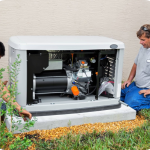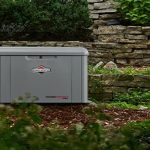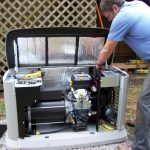Among the problems characteristic of the diesel generator, wet stacking is an important problem that negatively affects the efficiency and service life of generators. Various research studies reveal that as much as 20% of diesel generator problems are related to wet stacking, and therefore, a major concern for owners of the generators. This article explores the causes of wet stacking generator, their impact on generator performance, and effective prevention strategies.
Whether you’re dealing with wet stacking on a generator or looking to maintain your crankcase system, understanding this issue is key to long-term generator health.
What is a Wet Stacking Generator?
Wet stacking generator refers to the accumulation of unburned fuel, carbon, and soot within the exhaust system of a diesel engine. This generally presents itself when a generator is run at low loads for some time. As diesel engines are expected to be operated at greater temperatures and loads, when they are not, there will be incomplete combustion causing wet stacking.
Common Causes of Wet Stacking in Diesel Engines
Low Load Operation
One of the leading causes of wet stacking generator and blow by engine is running a generator below 30% of its rated load capacity. This creates rough running and large quantities of combustibles and carbon in the exhaust when the load is too low.
Poor Maintenance Practices
A neglected crankcase system can exacerbate generator wet stacking. Crankcase breathing helps in proper air circulation and a dirty or rusted crankcase breather contributes to combustion inefficiencies besides affecting air circulation.
Cold Operating Temperatures
Almost all diesel engines depend on the temperature to give the best combustion performance. Cold start-ups increase submerged thermal loss, and whenever the generator is started and stopped or operates at low temperatures, generator wet stacking becomes probable.
Effects of Wet Stacking on Generator
Wet stacking not only reduces the current efficiency of the generator but also causes long-term impairment of efficiency. When there is a lot of unburned fuel left and carbon buildup in the exhaust, it can contribute to more wear on the valve, pistons, injector, etc. This may cause expensive repairs over time or the outright need to replace a generator earlier than should have been the case. Further, wet stacking degrades the overall average fuel efficiency, consequently increasing the cost of operation. If you want to reduce the occurrence of such issues and increase the productivity of the generator, thereby reducing its life span, you have to prevent the problem through power generator maintenance and load testing, among others.
Reduced Efficiency
Wondering why generator not producing power? Wet stacking generator significantly reduces efficiency as the engine struggles to achieve optimal combustion.
Increased Emissions
A wet stacking generator produces higher levels of harmful emissions due to incomplete fuel combustion.
Component Damage
Long-term wet stacking has severe effects on various parts of the generators such as the exhaust system, valves, the pistons, and hence in the long run requires expensive repairs.
Reduced Lifespan
Wondering how to fix low voltage output generator? This situation damages the generator and spikes its replacement rates if not corrected by routinely preventing wet stacks.
How to Prevent Wet Stacking Generator
Regular Load Testing
Load testing is among the best ways of preventing wet stacking from occurring on a generator. It is also correct to operate your generator at 70-80% of your rated load for some time to burn the carbon deposits and avoid the accumulation of unburned fuels.
Maintain the Crankcase Ventilation System
A well-maintained crankcase ventilation system is essential for efficient generator performance. Some vehicles have crankcase breather filters; replace old or dirty ones with clean ones or clean them to offer free airflow and efficiency of the combustion chamber.
Use Load Banks
For generators that are rarely used or operate in low-load scenarios, investing in a load bank can help simulate optimal operating conditions, preventing a wet stacking generator.
Watch Operating Temperatures
Diesel generators should be allowed to reach their optimal temperature for them to start as soon as needed. This helps in reducing incomplete combustion and prevents wet stacking generator.
The Role of Generator Services in Wet Stacking Prevention
Generator warranty repair service plays a crucial role in preventing wet stacking. Regular maintenance, including crankcase system checks and load testing, ensures your generator operates at peak efficiency. By addressing issues like diesel engine wet stacking early, professional services help extend the life of your generator.
How Wet Stacking Relates to the Crankcase System
The crankcase system directly impacts a generator’s combustion efficiency. If the crankcase breather system is in poor or poor condition, pressure increases, which results in insufficient combustion, and wet stacking. Proper maintenance of crank ventilation hoses and crankshaft breather filters can significantly reduce the risk of a wet stacking generator.
Conclusion
Wet stacking generator is a preventable issue that requires proper maintenance and operational practices. By understanding the causes and effects of diesel wet stacking, homeowners can take proactive steps to protect their generators. Regular load testing, maintaining the crankcase ventilation, and investing in professional services are essential for long-term performance and efficiency. At Myrtle Beach Generators, we are concerned with the future problems that a homeowner might experience in their home, like wet stacking. Whether you’re searching for home generator installation near me or need routine maintenance and crankcase ventilation checks, we ensure your generator performs at its best.
Frequently Asked Questions
What is wet stacking a generator?
Wet stacking is the name given to accumulated fuel and carbon residues in the diesel generator’s exhaust system due to the use of low loading.
What can you do to avoid wet stacking on a generator?
Regular load testing, maintaining the crankcase system, and using load banks are effective strategies to prevent wet stacking on a generator.
What leads to a wet stacking generator?
Wet stacking is believed to happen in diesel engines due to insufficient fuel burn caused by low load operation, low temperatures, or faulty maintenance.
What does wet stacking do to a generator?
A wet stack lowers the efficiency of the generator, raises emissions, harms parts, and shortens the generator’s lifespan.
How do generator services help prevent wet stacking?
These services provide regular maintenance, including load testing and crankcase system checks, ensuring optimal performance and preventing issues like wet stacking.










